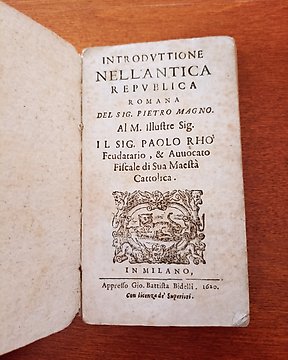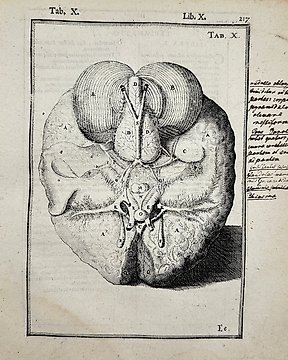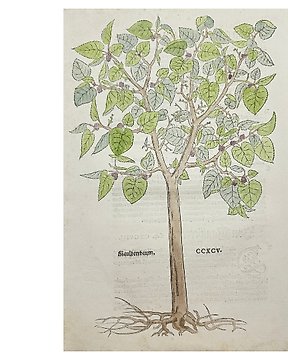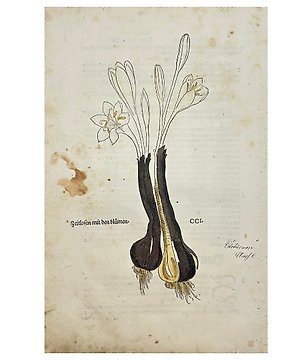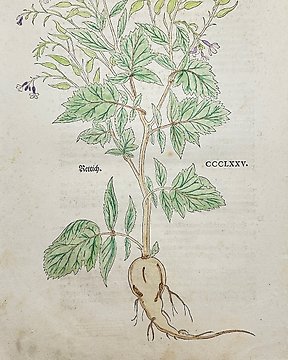Wonderful item perfectly described
Προβολή μετάφρασηςSvetonius - Suetonius Tranquillus cum Philippi Beroaldi et Marci Antonii Sabellici Commentarius - 1506
Αρ. 85436943



(HISTORY, ILLUSTRATED, SURGERY, BINDING) GAIUS SUETONIUS TRANQUILLUS (c. 69-122)
Suetonius Tranquillus cum Philippi Beroaldi et Marci Antonii Sabellici Commentarius. Cum figuris nuper additis. (Venetiis, per Ioannem Rubeum Vercellensem, 1506).
Folio; [4], [1-16], 17-358 leaves; sign.: aa4, a-z8, &8, [con]8, [rum]8, A-S8, T6 (colophon and register on leaf T6r). Rich iconographical apparatus including numerous woodcut pictorial initials and vignettes depicting scenes from the life of the Caesars. Wonderful contemporary blind-stamped binding in brown-red calf with four metal clasps (one on each side); upper spine-end restored. Five leaves browned, because of paper quality, otherwise very fine.
FIRST ILLUSTRATED EDITION, WITH 80 EXQUISITE WOODCUTS, a magnificent book ,very rare to find in a so fascinating binding, truly valuable (the only available copy on the market, bound in a simple contemporary vellum is offered at 7.000 € !)
Although this edition of the Lives of the Twelve Caesars is particularly appreciated for the philological care and the extensive historical-literary commentaries by the humanists Filippo Beroaldo the Elder (1453 - 1505) - or. ed. Bologna, Benedetto Faelli, 1493 - and Marco Antonio Sabellico (1436 - 1506) - or. ed. Venezia, Battista Torti, 1490 -, the reason behind its popularity lies in a purely scientific detail. In fact, it shows the EARLIEST KNOWN PRINTED ILLUSTRATION OF A CAESAREAN SECTION (incipital vignette of the Life of Julius Caesar, leaf a1r). The legend of the first occurrence of this particular surgical procedure as associated with the birth of Julius Caesar was born with Pliny the Elder, who in Naturalis Historia VII, 47, traces the name Caesar as related to delivery through the section of the uterus, a caeso matris utero. However, this is a well-known historical forgery, since, although already from the 8th century BC, by virtue of the Lex Regia attributed to Numa Pompilius (754 - 673 BC), the practice of caesarean section was known and widespread, it concerned the extraction of the fetes from the women who died during labour, which excludes the mother of Julius Caesar, Aurelia Cotta (c. 120 - 54 B.C.), who survived. In addition, the first testimonies of caesarean sections performed on living women date back, just like the present work, to the early years of the 16th century. In the Traitté nouveau de l’hystérotomotokie ou enfantement caesarien (Paris, Denys du Val, 1581) by the physician and surgeon François Rousset (c. 1535 - a. 1603), the methodology and techniques of caesarean section are exposed for the first time. In the second edition of the Latin translation of the text, ΥΣΤΕΡΟΤΟΜΟΤΟΚΙΑ Francisci Rousseti, Gallice primum edita, nunc vero Caspari Bauhini Medicinae Doct. & Profess. In Acad. Basiliensi Opera Latine reddita (Basel, Konrad von Waldkirch, 1588), edited by the Swiss physician and botanist Gaspard Bauhin (1560 - 1624), we find the earliest description of a successful caesarean section. The operation took place around 1500, when Jakob Nufer, a sow-gelder, succeeded in the procedure, performed on his wife, Elisabeth Alespachin, who survived and also gave birth to other children (pp. 177-179). Rather than history per se, Suetonius’ Lives abound in anecdotes with which he portrays the characters of the Caesars, and presents insights into the customs and manner of the times. As noted by the historian and philologist K. R. Bradley in the introduction to the 1930 Loeb edition of Suetonius: “The banquet hall and the bedchamber figure more largely in his narrative than do the forum and the camps. And, as the real man lurks inevitably beneath the purple which conceals him, this method gives us a series of indelible portraits drawn with the objective art of the skilled cartoonist who sharply differentiates individuals by stressing their most prominent characteristics.” (p. viii).
CNCE 36040; EBERT 21895; ESSELING I, 208; SANDER III, 7143; WELLCOME I, 6139
(HISTORY, ILLUSTRATED, SURGERY, BINDING) GAIUS SUETONIUS TRANQUILLUS (c. 69-122)
Suetonius Tranquillus cum Philippi Beroaldi et Marci Antonii Sabellici Commentarius. Cum figuris nuper additis. (Venetiis, per Ioannem Rubeum Vercellensem, 1506).
Folio; [4], [1-16], 17-358 leaves; sign.: aa4, a-z8, &8, [con]8, [rum]8, A-S8, T6 (colophon and register on leaf T6r). Rich iconographical apparatus including numerous woodcut pictorial initials and vignettes depicting scenes from the life of the Caesars. Wonderful contemporary blind-stamped binding in brown-red calf with four metal clasps (one on each side); upper spine-end restored. Five leaves browned, because of paper quality, otherwise very fine.
FIRST ILLUSTRATED EDITION, WITH 80 EXQUISITE WOODCUTS, a magnificent book ,very rare to find in a so fascinating binding, truly valuable (the only available copy on the market, bound in a simple contemporary vellum is offered at 7.000 € !)
Although this edition of the Lives of the Twelve Caesars is particularly appreciated for the philological care and the extensive historical-literary commentaries by the humanists Filippo Beroaldo the Elder (1453 - 1505) - or. ed. Bologna, Benedetto Faelli, 1493 - and Marco Antonio Sabellico (1436 - 1506) - or. ed. Venezia, Battista Torti, 1490 -, the reason behind its popularity lies in a purely scientific detail. In fact, it shows the EARLIEST KNOWN PRINTED ILLUSTRATION OF A CAESAREAN SECTION (incipital vignette of the Life of Julius Caesar, leaf a1r). The legend of the first occurrence of this particular surgical procedure as associated with the birth of Julius Caesar was born with Pliny the Elder, who in Naturalis Historia VII, 47, traces the name Caesar as related to delivery through the section of the uterus, a caeso matris utero. However, this is a well-known historical forgery, since, although already from the 8th century BC, by virtue of the Lex Regia attributed to Numa Pompilius (754 - 673 BC), the practice of caesarean section was known and widespread, it concerned the extraction of the fetes from the women who died during labour, which excludes the mother of Julius Caesar, Aurelia Cotta (c. 120 - 54 B.C.), who survived. In addition, the first testimonies of caesarean sections performed on living women date back, just like the present work, to the early years of the 16th century. In the Traitté nouveau de l’hystérotomotokie ou enfantement caesarien (Paris, Denys du Val, 1581) by the physician and surgeon François Rousset (c. 1535 - a. 1603), the methodology and techniques of caesarean section are exposed for the first time. In the second edition of the Latin translation of the text, ΥΣΤΕΡΟΤΟΜΟΤΟΚΙΑ Francisci Rousseti, Gallice primum edita, nunc vero Caspari Bauhini Medicinae Doct. & Profess. In Acad. Basiliensi Opera Latine reddita (Basel, Konrad von Waldkirch, 1588), edited by the Swiss physician and botanist Gaspard Bauhin (1560 - 1624), we find the earliest description of a successful caesarean section. The operation took place around 1500, when Jakob Nufer, a sow-gelder, succeeded in the procedure, performed on his wife, Elisabeth Alespachin, who survived and also gave birth to other children (pp. 177-179). Rather than history per se, Suetonius’ Lives abound in anecdotes with which he portrays the characters of the Caesars, and presents insights into the customs and manner of the times. As noted by the historian and philologist K. R. Bradley in the introduction to the 1930 Loeb edition of Suetonius: “The banquet hall and the bedchamber figure more largely in his narrative than do the forum and the camps. And, as the real man lurks inevitably beneath the purple which conceals him, this method gives us a series of indelible portraits drawn with the objective art of the skilled cartoonist who sharply differentiates individuals by stressing their most prominent characteristics.” (p. viii).
CNCE 36040; EBERT 21895; ESSELING I, 208; SANDER III, 7143; WELLCOME I, 6139
- 4
- 1
- 0
Very citified
Προβολή μετάφρασηςTutto bene, grazie.
Προβολή μετάφρασηςNão era precisa, nem completa, a descrição feita.
Προβολή μετάφρασηςPerfetto
Προβολή μετάφρασης- 4
- 1
- 0
Wonderful item perfectly described
Προβολή μετάφρασης